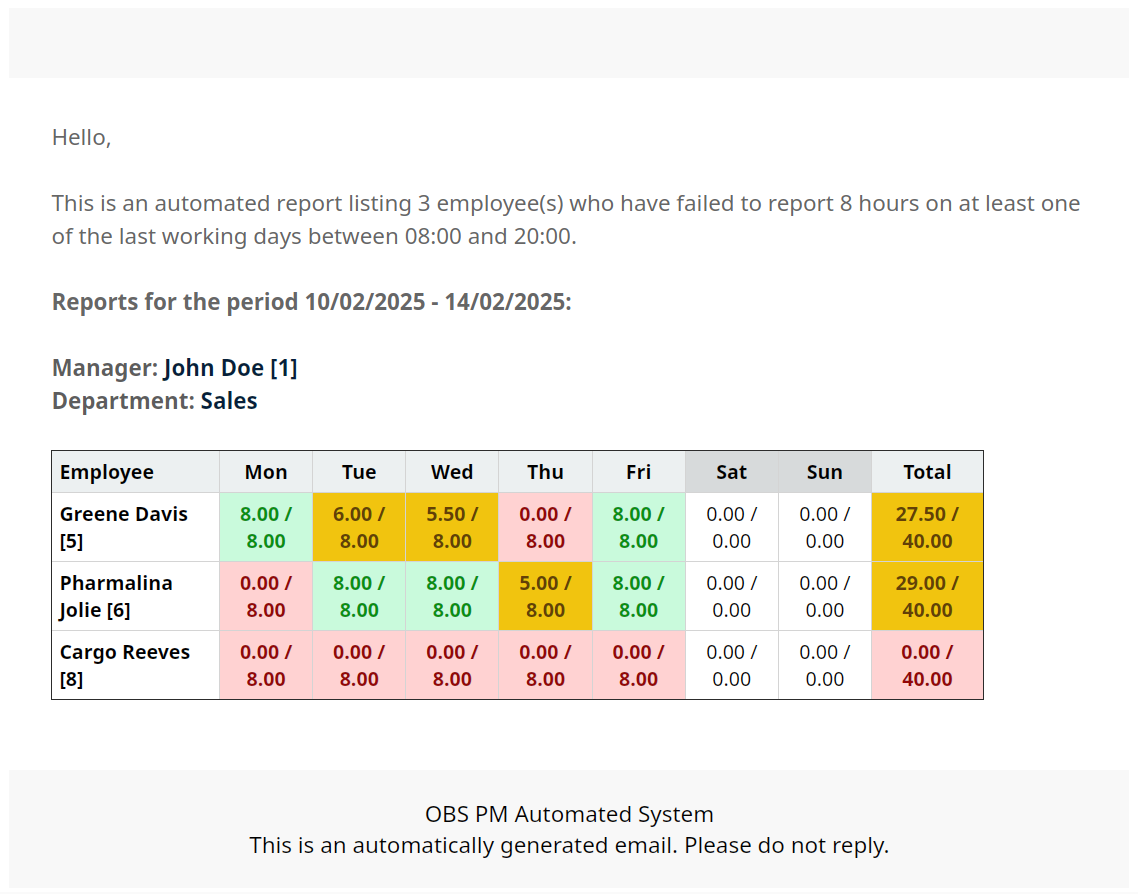Project Management
/Weekly Time Tracking Report
Weekly Time Tracking Report
The Weekly Time Tracking process ensures that employees correctly report their working hours and provides automated notifications to employees, their managers, and key executives within the company. This process is designed to maintain accountability, track employee time efficiently, and notify stakeholders when time-tracking requirements are not met.

Figure: Example of the email sent to managers.
Key Components
- Time Tracking Data Creation – Every week, the system generates a record for each active employee, outlining their expected working hours.
- Automated Tracking & Validation – The system checks reported hours against required working hours.
- Status Evaluation – Employees are categorized based on their reporting compliance.
- Automated Notifications – If an employee has not met the required hours, notifications are sent to the employee, their manager, and senior executives.
How the Process Works
Step 1: Generating Weekly Time Tracking Data
Every Monday before 9:00 AM, the system generates a time tracking report for each active employee, including:
- Employee’s name and manager
- Expected working hours for each day (Monday – Friday)
- Actual hours reported
- A summary of total hours worked
- Status based on compliance
Step 2: Status Evaluation & Compliance Check
Employees are classified into one of the following statuses:
- Compliant – All required hours have been reported.
- Partially Compliant – Some hours are missing.
- Non-Compliant – No hours have been reported.
- Not Applicable – Employee is on leave (e.g., vacation, sick leave).
Step 3: Sending Notifications
If employees have not fully reported their hours, email notifications are sent:
1. Employee Notification
Sent to employees who have not met the required working hours, providing a summary of missing time and a reminder to update records.
2. Manager Notification
Sent to managers every Monday before 9:00 AM, summarizing all employees who have not met their required hours, allowing managers to follow up.
3. Executive-Level Notification
Sent to senior executives (CEO, CFO, HR, etc.) before 9:00 AM every Monday, providing a comprehensive report on all non-compliant employees across the organization.
Step 4: Follow-Up Actions
- Employees are expected to update their reported hours.
- Managers follow up with team members to ensure compliance.
- HR and senior executives may intervene in cases of repeated non-compliance.
Scheduling & Timing
The Weekly Time Tracking process follows a structured schedule:
- Monday before 9:00 AM: Time-tracking data is generated, and notifications are sent.
- Monday Meetings: Managers and executives review reports during their meetings.
Benefits of the Weekly Time Tracking Process
- Ensures Accountability: Employees and managers track missing time entries.
- Streamlines Compliance: Automates reminders, reducing manual effort.
- Provides Transparency: Executives can assess compliance trends across the organization.
- Supports Decision-Making: HR and leadership can intervene when necessary.
Conclusion
The Weekly Time Tracking process is an automated system that ensures employees report their working hours correctly. Through timely notifications and clear reporting, the system helps maintain accountability and improves compliance. This approach enhances productivity, streamlines workforce management, and supports informed decision-making across all levels.
